University E-waste Report: Environmental Impact and Recommendations
VerifiedAdded on 2022/08/20
|6
|1443
|46
Report
AI Summary
This report examines the significant and growing problem of electronic waste (e-waste) and its detrimental effects on the environment and human health. It highlights that e-waste, including items like computers, phones, and batteries, contains toxic materials such as lead, zinc, nickel, and chromium, which can cause serious health issues. The report discusses how improper disposal of e-waste leads to the release of harmful chemicals into the atmosphere and groundwater, affecting both human health and marine life. It also provides recommendations for managers and consumers, such as ensuring electronics are not trashed, promoting reuse and recycling, using recyclable materials, and making strategic purchasing decisions. The report emphasizes the need for effective e-waste management programs to reduce environmental impact and promote sustainability, offering a comprehensive overview of the issue and potential solutions.
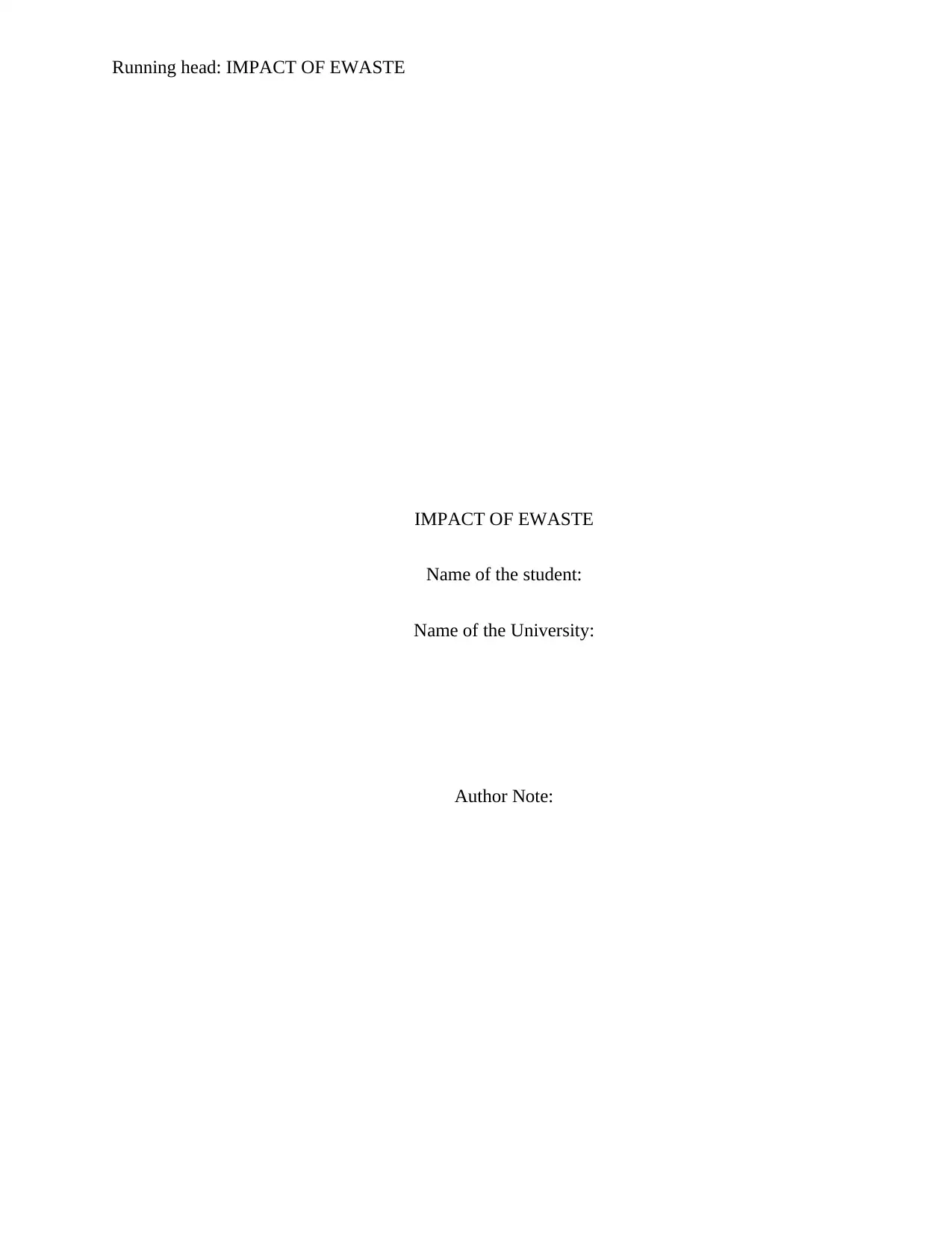
Running head: IMPACT OF EWASTE
IMPACT OF EWASTE
Name of the student:
Name of the University:
Author Note:
IMPACT OF EWASTE
Name of the student:
Name of the University:
Author Note:
Paraphrase This Document
Need a fresh take? Get an instant paraphrase of this document with our AI Paraphraser
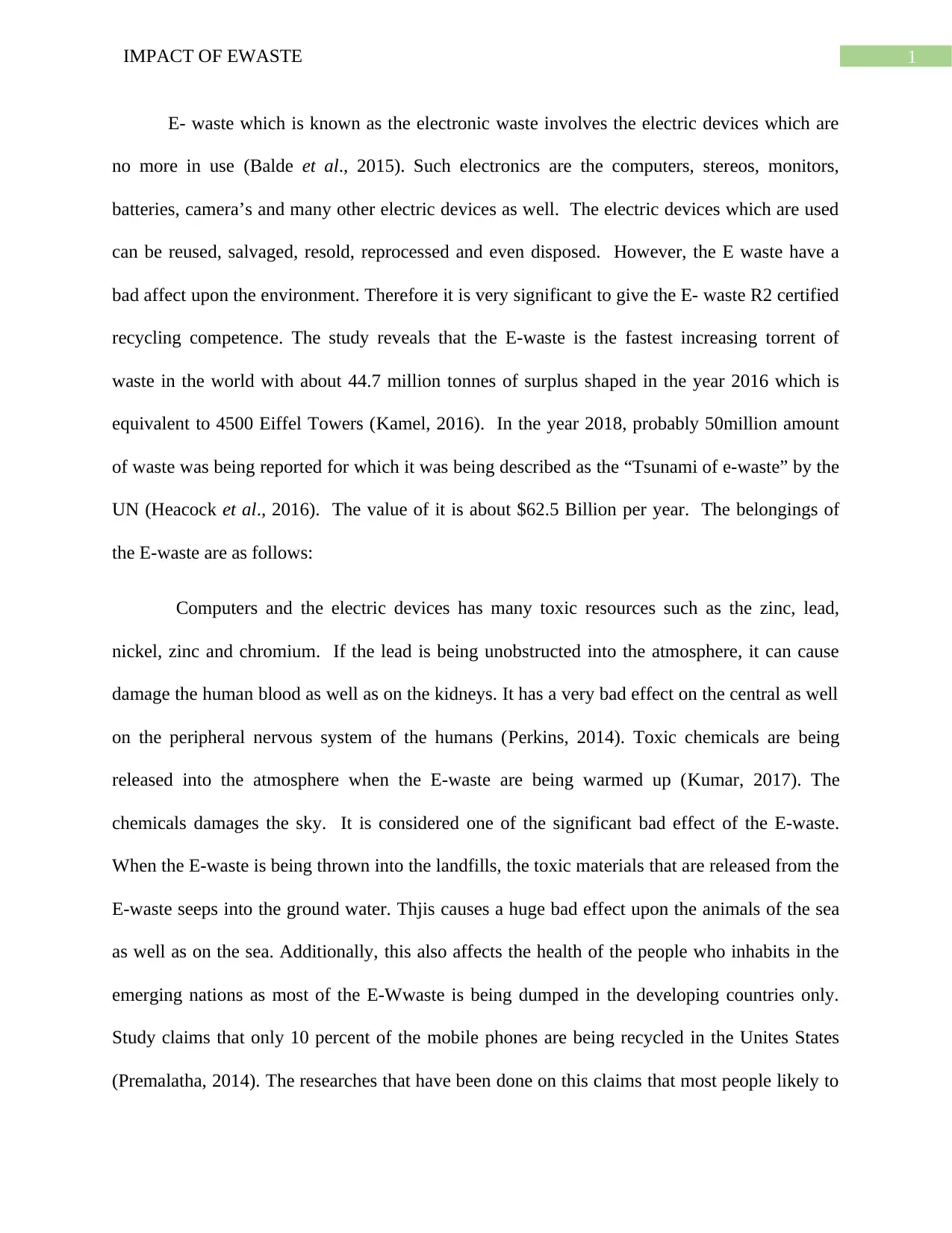
1IMPACT OF EWASTE
E- waste which is known as the electronic waste involves the electric devices which are
no more in use (Balde et al., 2015). Such electronics are the computers, stereos, monitors,
batteries, camera’s and many other electric devices as well. The electric devices which are used
can be reused, salvaged, resold, reprocessed and even disposed. However, the E waste have a
bad affect upon the environment. Therefore it is very significant to give the E- waste R2 certified
recycling competence. The study reveals that the E-waste is the fastest increasing torrent of
waste in the world with about 44.7 million tonnes of surplus shaped in the year 2016 which is
equivalent to 4500 Eiffel Towers (Kamel, 2016). In the year 2018, probably 50million amount
of waste was being reported for which it was being described as the “Tsunami of e-waste” by the
UN (Heacock et al., 2016). The value of it is about $62.5 Billion per year. The belongings of
the E-waste are as follows:
Computers and the electric devices has many toxic resources such as the zinc, lead,
nickel, zinc and chromium. If the lead is being unobstructed into the atmosphere, it can cause
damage the human blood as well as on the kidneys. It has a very bad effect on the central as well
on the peripheral nervous system of the humans (Perkins, 2014). Toxic chemicals are being
released into the atmosphere when the E-waste are being warmed up (Kumar, 2017). The
chemicals damages the sky. It is considered one of the significant bad effect of the E-waste.
When the E-waste is being thrown into the landfills, the toxic materials that are released from the
E-waste seeps into the ground water. Thjis causes a huge bad effect upon the animals of the sea
as well as on the sea. Additionally, this also affects the health of the people who inhabits in the
emerging nations as most of the E-Wwaste is being dumped in the developing countries only.
Study claims that only 10 percent of the mobile phones are being recycled in the Unites States
(Premalatha, 2014). The researches that have been done on this claims that most people likely to
E- waste which is known as the electronic waste involves the electric devices which are
no more in use (Balde et al., 2015). Such electronics are the computers, stereos, monitors,
batteries, camera’s and many other electric devices as well. The electric devices which are used
can be reused, salvaged, resold, reprocessed and even disposed. However, the E waste have a
bad affect upon the environment. Therefore it is very significant to give the E- waste R2 certified
recycling competence. The study reveals that the E-waste is the fastest increasing torrent of
waste in the world with about 44.7 million tonnes of surplus shaped in the year 2016 which is
equivalent to 4500 Eiffel Towers (Kamel, 2016). In the year 2018, probably 50million amount
of waste was being reported for which it was being described as the “Tsunami of e-waste” by the
UN (Heacock et al., 2016). The value of it is about $62.5 Billion per year. The belongings of
the E-waste are as follows:
Computers and the electric devices has many toxic resources such as the zinc, lead,
nickel, zinc and chromium. If the lead is being unobstructed into the atmosphere, it can cause
damage the human blood as well as on the kidneys. It has a very bad effect on the central as well
on the peripheral nervous system of the humans (Perkins, 2014). Toxic chemicals are being
released into the atmosphere when the E-waste are being warmed up (Kumar, 2017). The
chemicals damages the sky. It is considered one of the significant bad effect of the E-waste.
When the E-waste is being thrown into the landfills, the toxic materials that are released from the
E-waste seeps into the ground water. Thjis causes a huge bad effect upon the animals of the sea
as well as on the sea. Additionally, this also affects the health of the people who inhabits in the
emerging nations as most of the E-Wwaste is being dumped in the developing countries only.
Study claims that only 10 percent of the mobile phones are being recycled in the Unites States
(Premalatha, 2014). The researches that have been done on this claims that most people likely to
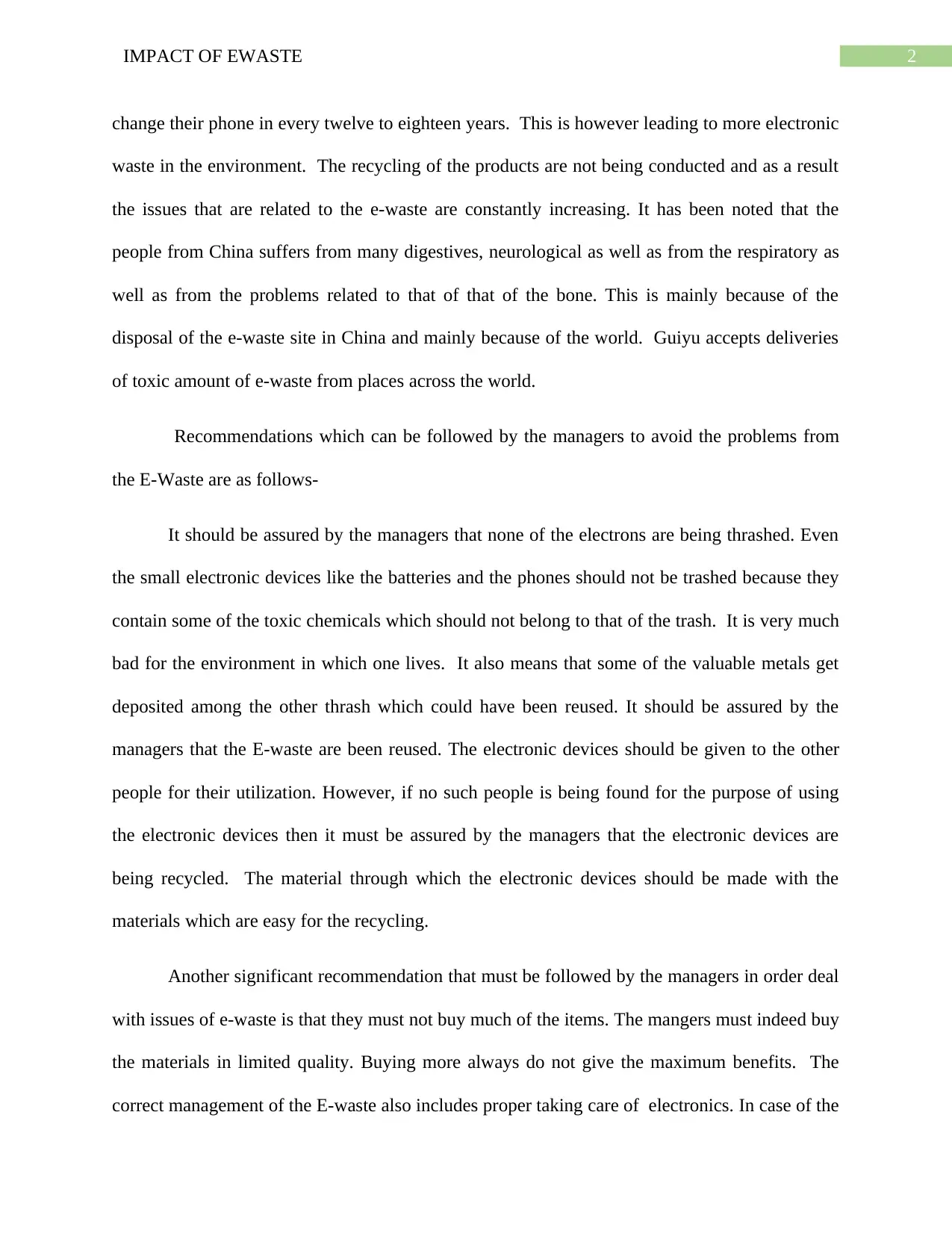
2IMPACT OF EWASTE
change their phone in every twelve to eighteen years. This is however leading to more electronic
waste in the environment. The recycling of the products are not being conducted and as a result
the issues that are related to the e-waste are constantly increasing. It has been noted that the
people from China suffers from many digestives, neurological as well as from the respiratory as
well as from the problems related to that of that of the bone. This is mainly because of the
disposal of the e-waste site in China and mainly because of the world. Guiyu accepts deliveries
of toxic amount of e-waste from places across the world.
Recommendations which can be followed by the managers to avoid the problems from
the E-Waste are as follows-
It should be assured by the managers that none of the electrons are being thrashed. Even
the small electronic devices like the batteries and the phones should not be trashed because they
contain some of the toxic chemicals which should not belong to that of the trash. It is very much
bad for the environment in which one lives. It also means that some of the valuable metals get
deposited among the other thrash which could have been reused. It should be assured by the
managers that the E-waste are been reused. The electronic devices should be given to the other
people for their utilization. However, if no such people is being found for the purpose of using
the electronic devices then it must be assured by the managers that the electronic devices are
being recycled. The material through which the electronic devices should be made with the
materials which are easy for the recycling.
Another significant recommendation that must be followed by the managers in order deal
with issues of e-waste is that they must not buy much of the items. The mangers must indeed buy
the materials in limited quality. Buying more always do not give the maximum benefits. The
correct management of the E-waste also includes proper taking care of electronics. In case of the
change their phone in every twelve to eighteen years. This is however leading to more electronic
waste in the environment. The recycling of the products are not being conducted and as a result
the issues that are related to the e-waste are constantly increasing. It has been noted that the
people from China suffers from many digestives, neurological as well as from the respiratory as
well as from the problems related to that of that of the bone. This is mainly because of the
disposal of the e-waste site in China and mainly because of the world. Guiyu accepts deliveries
of toxic amount of e-waste from places across the world.
Recommendations which can be followed by the managers to avoid the problems from
the E-Waste are as follows-
It should be assured by the managers that none of the electrons are being thrashed. Even
the small electronic devices like the batteries and the phones should not be trashed because they
contain some of the toxic chemicals which should not belong to that of the trash. It is very much
bad for the environment in which one lives. It also means that some of the valuable metals get
deposited among the other thrash which could have been reused. It should be assured by the
managers that the E-waste are been reused. The electronic devices should be given to the other
people for their utilization. However, if no such people is being found for the purpose of using
the electronic devices then it must be assured by the managers that the electronic devices are
being recycled. The material through which the electronic devices should be made with the
materials which are easy for the recycling.
Another significant recommendation that must be followed by the managers in order deal
with issues of e-waste is that they must not buy much of the items. The mangers must indeed buy
the materials in limited quality. Buying more always do not give the maximum benefits. The
correct management of the E-waste also includes proper taking care of electronics. In case of the
⊘ This is a preview!⊘
Do you want full access?
Subscribe today to unlock all pages.

Trusted by 1+ million students worldwide
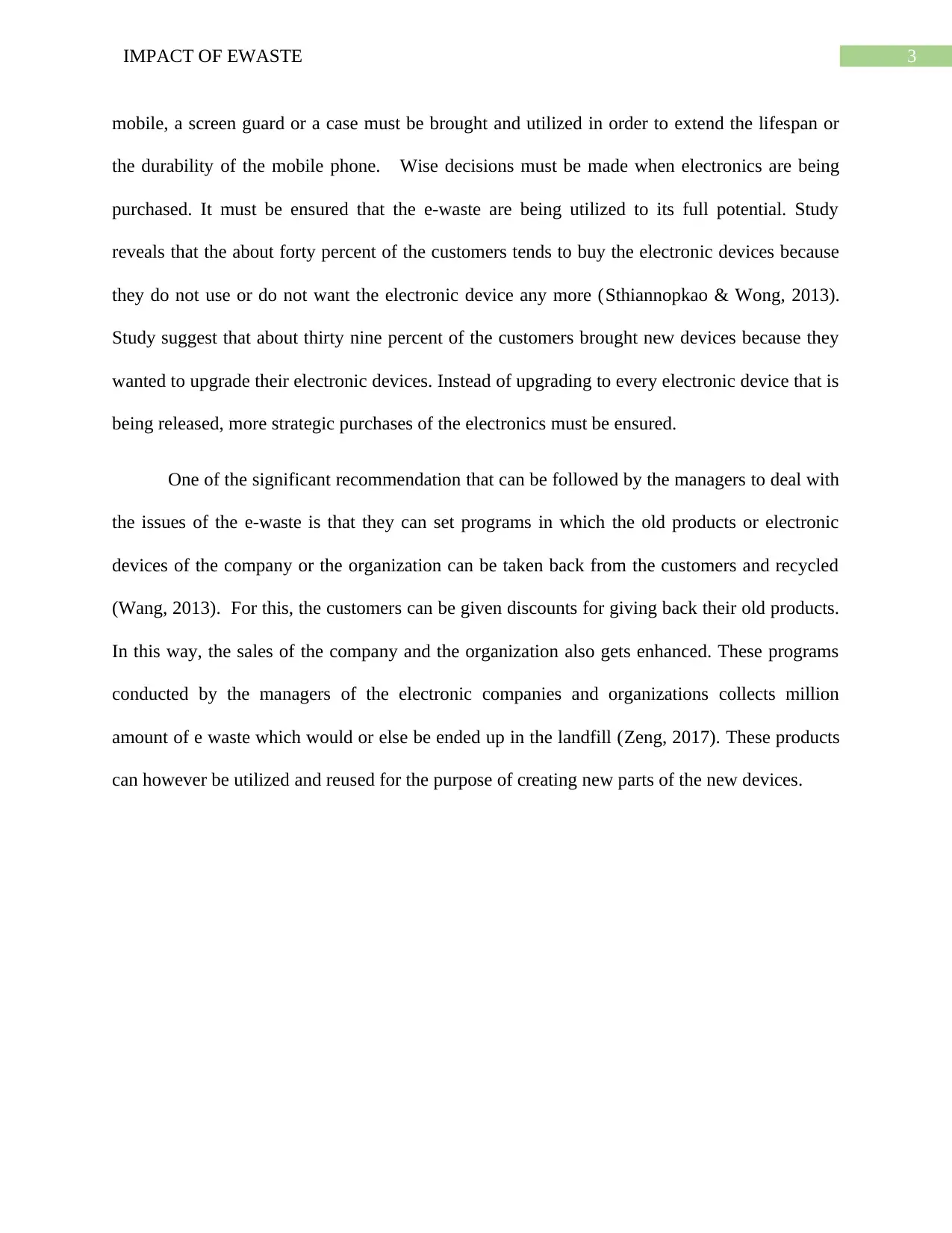
3IMPACT OF EWASTE
mobile, a screen guard or a case must be brought and utilized in order to extend the lifespan or
the durability of the mobile phone. Wise decisions must be made when electronics are being
purchased. It must be ensured that the e-waste are being utilized to its full potential. Study
reveals that the about forty percent of the customers tends to buy the electronic devices because
they do not use or do not want the electronic device any more (Sthiannopkao & Wong, 2013).
Study suggest that about thirty nine percent of the customers brought new devices because they
wanted to upgrade their electronic devices. Instead of upgrading to every electronic device that is
being released, more strategic purchases of the electronics must be ensured.
One of the significant recommendation that can be followed by the managers to deal with
the issues of the e-waste is that they can set programs in which the old products or electronic
devices of the company or the organization can be taken back from the customers and recycled
(Wang, 2013). For this, the customers can be given discounts for giving back their old products.
In this way, the sales of the company and the organization also gets enhanced. These programs
conducted by the managers of the electronic companies and organizations collects million
amount of e waste which would or else be ended up in the landfill (Zeng, 2017). These products
can however be utilized and reused for the purpose of creating new parts of the new devices.
mobile, a screen guard or a case must be brought and utilized in order to extend the lifespan or
the durability of the mobile phone. Wise decisions must be made when electronics are being
purchased. It must be ensured that the e-waste are being utilized to its full potential. Study
reveals that the about forty percent of the customers tends to buy the electronic devices because
they do not use or do not want the electronic device any more (Sthiannopkao & Wong, 2013).
Study suggest that about thirty nine percent of the customers brought new devices because they
wanted to upgrade their electronic devices. Instead of upgrading to every electronic device that is
being released, more strategic purchases of the electronics must be ensured.
One of the significant recommendation that can be followed by the managers to deal with
the issues of the e-waste is that they can set programs in which the old products or electronic
devices of the company or the organization can be taken back from the customers and recycled
(Wang, 2013). For this, the customers can be given discounts for giving back their old products.
In this way, the sales of the company and the organization also gets enhanced. These programs
conducted by the managers of the electronic companies and organizations collects million
amount of e waste which would or else be ended up in the landfill (Zeng, 2017). These products
can however be utilized and reused for the purpose of creating new parts of the new devices.
Paraphrase This Document
Need a fresh take? Get an instant paraphrase of this document with our AI Paraphraser
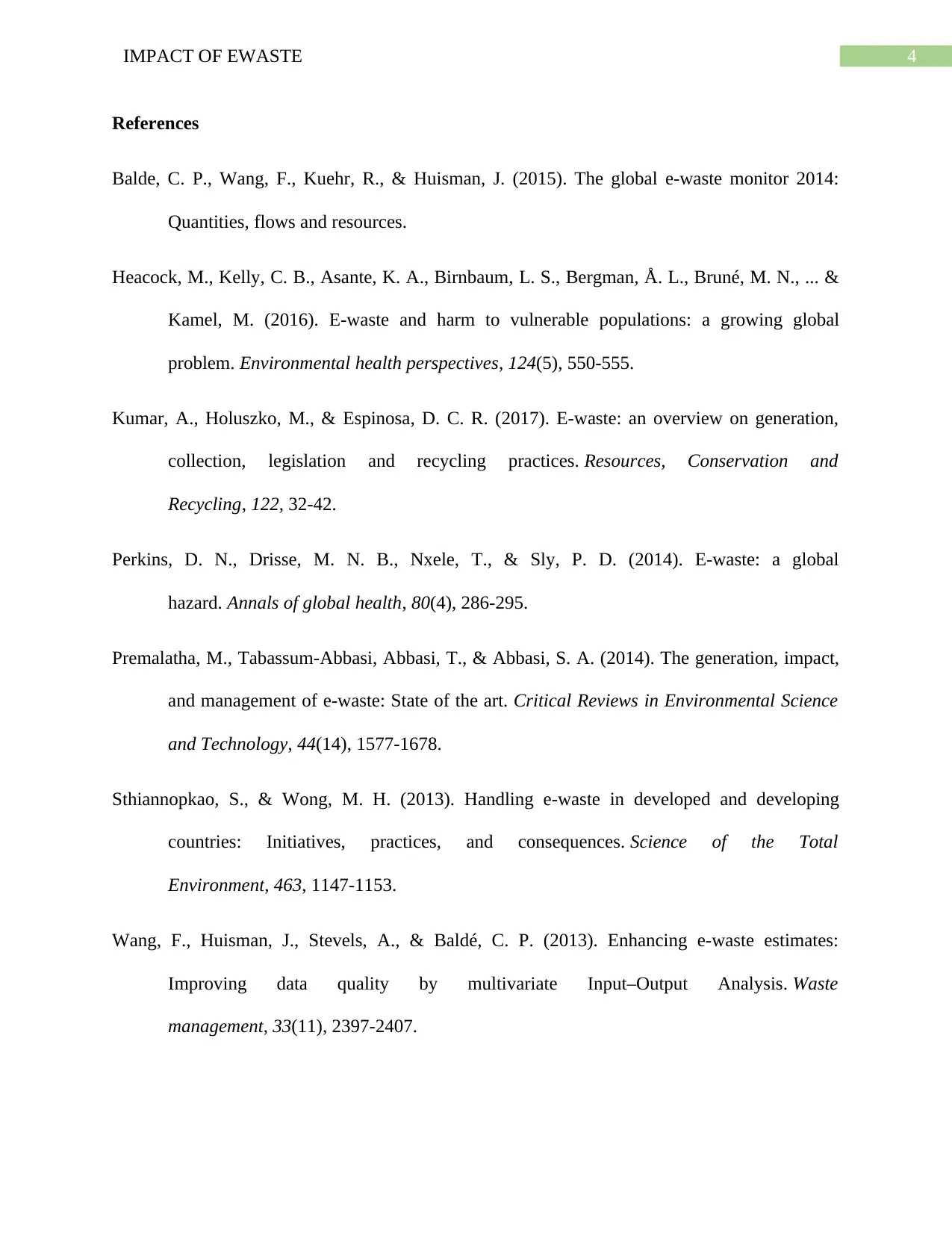
4IMPACT OF EWASTE
References
Balde, C. P., Wang, F., Kuehr, R., & Huisman, J. (2015). The global e-waste monitor 2014:
Quantities, flows and resources.
Heacock, M., Kelly, C. B., Asante, K. A., Birnbaum, L. S., Bergman, Å. L., Bruné, M. N., ... &
Kamel, M. (2016). E-waste and harm to vulnerable populations: a growing global
problem. Environmental health perspectives, 124(5), 550-555.
Kumar, A., Holuszko, M., & Espinosa, D. C. R. (2017). E-waste: an overview on generation,
collection, legislation and recycling practices. Resources, Conservation and
Recycling, 122, 32-42.
Perkins, D. N., Drisse, M. N. B., Nxele, T., & Sly, P. D. (2014). E-waste: a global
hazard. Annals of global health, 80(4), 286-295.
Premalatha, M., Tabassum-Abbasi, Abbasi, T., & Abbasi, S. A. (2014). The generation, impact,
and management of e-waste: State of the art. Critical Reviews in Environmental Science
and Technology, 44(14), 1577-1678.
Sthiannopkao, S., & Wong, M. H. (2013). Handling e-waste in developed and developing
countries: Initiatives, practices, and consequences. Science of the Total
Environment, 463, 1147-1153.
Wang, F., Huisman, J., Stevels, A., & Baldé, C. P. (2013). Enhancing e-waste estimates:
Improving data quality by multivariate Input–Output Analysis. Waste
management, 33(11), 2397-2407.
References
Balde, C. P., Wang, F., Kuehr, R., & Huisman, J. (2015). The global e-waste monitor 2014:
Quantities, flows and resources.
Heacock, M., Kelly, C. B., Asante, K. A., Birnbaum, L. S., Bergman, Å. L., Bruné, M. N., ... &
Kamel, M. (2016). E-waste and harm to vulnerable populations: a growing global
problem. Environmental health perspectives, 124(5), 550-555.
Kumar, A., Holuszko, M., & Espinosa, D. C. R. (2017). E-waste: an overview on generation,
collection, legislation and recycling practices. Resources, Conservation and
Recycling, 122, 32-42.
Perkins, D. N., Drisse, M. N. B., Nxele, T., & Sly, P. D. (2014). E-waste: a global
hazard. Annals of global health, 80(4), 286-295.
Premalatha, M., Tabassum-Abbasi, Abbasi, T., & Abbasi, S. A. (2014). The generation, impact,
and management of e-waste: State of the art. Critical Reviews in Environmental Science
and Technology, 44(14), 1577-1678.
Sthiannopkao, S., & Wong, M. H. (2013). Handling e-waste in developed and developing
countries: Initiatives, practices, and consequences. Science of the Total
Environment, 463, 1147-1153.
Wang, F., Huisman, J., Stevels, A., & Baldé, C. P. (2013). Enhancing e-waste estimates:
Improving data quality by multivariate Input–Output Analysis. Waste
management, 33(11), 2397-2407.

5IMPACT OF EWASTE
Zeng, X., Yang, C., Chiang, J. F., & Li, J. (2017). Innovating e-waste management: From
macroscopic to microscopic scales. Science of the Total Environment, 575, 1-5.
Zeng, X., Yang, C., Chiang, J. F., & Li, J. (2017). Innovating e-waste management: From
macroscopic to microscopic scales. Science of the Total Environment, 575, 1-5.
⊘ This is a preview!⊘
Do you want full access?
Subscribe today to unlock all pages.

Trusted by 1+ million students worldwide
1 out of 6
Related Documents
Your All-in-One AI-Powered Toolkit for Academic Success.
+13062052269
info@desklib.com
Available 24*7 on WhatsApp / Email
![[object Object]](/_next/static/media/star-bottom.7253800d.svg)
Unlock your academic potential
Copyright © 2020–2025 A2Z Services. All Rights Reserved. Developed and managed by ZUCOL.





